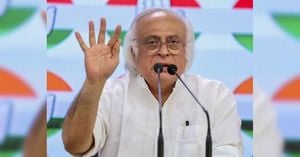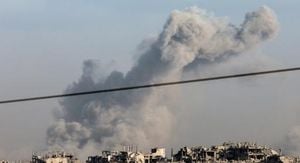The Iranian Rial has recently faced significant fluctuations against major currencies, raising eyebrows among economists and everyday citizens alike. This shift signals not just changes in value, but reflects larger economic circumstances at play within Iran.
According to reports from Reuters, the Rial hit its lowest point, trading at 450,000 Rials per US dollar, which marks a dramatic change from its previous averages. This depreciation has been attributed to various factors, including international sanctions, internal economic policies, and broader geopolitical tensions.
The Iranian government has pointed to foreign interference as one of the main reasons behind the currency's decline. Officials assert, "Continuous NATO sanctions and the West's economic pressures have led to inflation and market instability," as highlighted by the Iranian Tribune. Although officials claim to have implemented measures to stabilize the currency, such efforts have had little impact so far.
Shifting focus, the Rial's collapse has been particularly evident against the Euro and the Pound Sterling, also witnessing steep devaluations. The latest reports indicate the Rial standing at 500,000 against the Euro and 570,000 against the British Pound, showcasing the depth of its depreciation. The economic rift from these currency challenges brings concerning implications for Iranian consumers who rely heavily on imports.
The currency crisis is intertwined with Iran's broader economic challenges, such as inflation rates exceeding 40%, impacting purchasing power. This condition has sparked public unrest, with citizens complaining about skyrocketing prices for essentials like food, fuel, and medicine. The soaring inflation and depreciation lead many to argue for structural economic reforms to reinstate tangible value to the Rial.
Experts from economic think tanks suggest increases in foreign investments and reforms to boost the domestic economy could address such currency issues. These insights were discussed at the Economic Growth Forum, where analysts stressed on improving Iran's trade relationships to boost the Rial. They warned, "Only by addressing the dual challenges of external pressures and internal inefficiencies can the Rial regain stability." This prevalent sentiment indicates the urgency for Iran's policymakers to act decisively.
The future outlook for the Iranian Rial remains uncertain. Analysts from the Middle East Economic Review predict the national currency could experience volatility as long as geopolitical tensions endure. A noted economist stated, "The Rial will continue to suffer as long as Sanctions stymie economic growth and consumer confidence. Prioritizing diplomatic relations could provide much-needed relief for the currency."
Yet, amid the gloom, some market observers remain hopeful. They argue potential improvements can arise if Iran succeeds at reviving the nuclear agreement talks, possibly leading to reduced sanctions and quicker economic recovery. The consequences of such advancements could mean not just stabilization of the Rial, but potential revitalization of the overall Iranian economy.
Despite the turbulence, Iranian officials report they are devising plans to mitigate adverse impacts on the market. Proposed initiatives include increased state control over currency exchanges and implementing stringent regulations on speculative trade activities.
Nonetheless, the efficacy of these measures remains to be seen. Citizens remain skeptical, voicing their concerns over the government’s handling of the economic downturn through various media outlets. Regular citizens vent frustrations, declaring, "We cannot wait for change as prices rise daily!" These urgent pleas echo throughout the nation, intensifying the call for solutions.
Looking forward, the sustainability of Iran's currency hinges on effective governance and strategic economic policies aimed at alleviating domestic distress and shielding the Rial from external shocks. The path to stability may prove long and challenging, but for many Iranians, it is the only way to restore faith and confidence back to their currency.
Through all this, one fact remains glaringly obvious: the Iranian Rial’s exchange rate trends are not merely numbers on currency boards; they represent the lived experiences of millions trying to navigate life amid economic uncertainty. A change is needed, and the quest for solutions must be prioritized to safeguard the citizens’ well-being and preserve the economic integrity of the nation.



